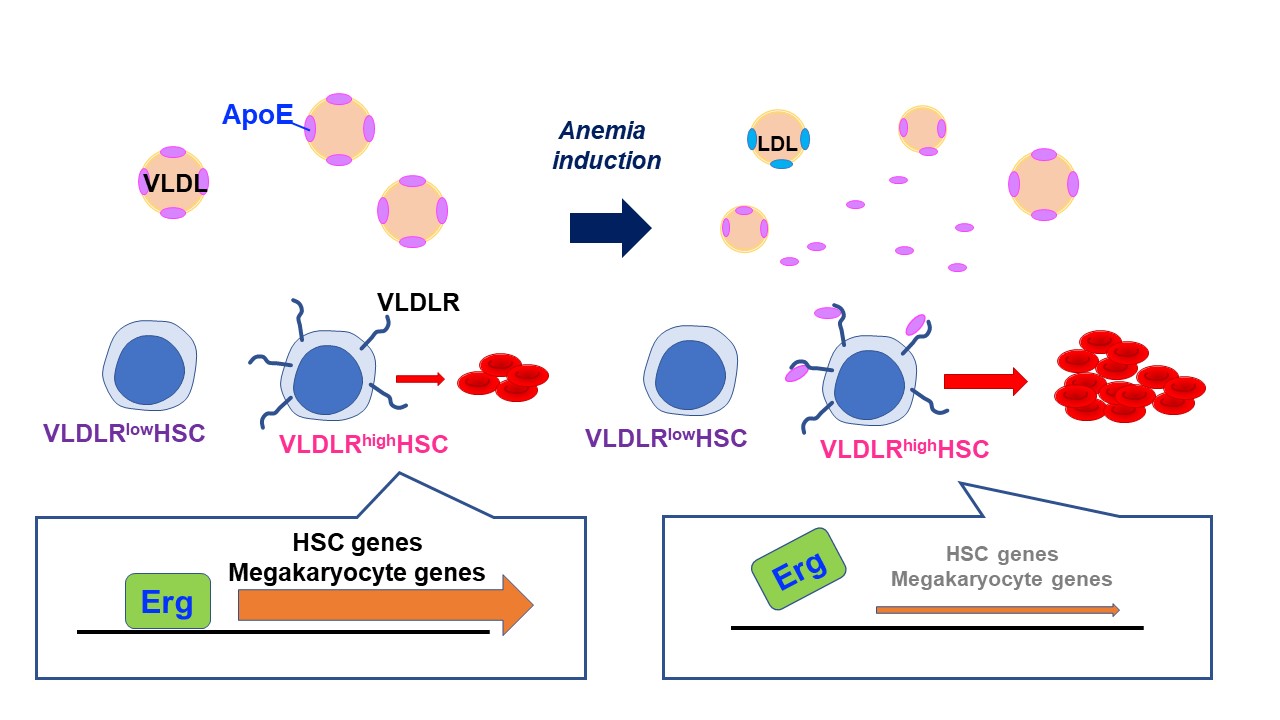Discovering a New Fashion of Regulation in Red Blood Cell Production

A Potential Future Target to Cure Severe Anemia in Patients Unresponsive to Standard Treatments
Red blood cells are the most abundant cells in the body. It has long been known that when red blood cells break down or anemia occurs due to bleeding, the hormone erythropoietin (EPO) increases, leading to the proliferation of immature cells (erythroblasts) that eventually become red blood cells, thus restoring the red blood cell count. However, how more primitive "hematopoietic stem cells" respond to severe anemia has been largely unclear. Hematopoietic stem cells have the ability to produce all types of blood cells, but lack receptors for erythropoietin, suggesting an unidentified mechanism must aid red blood cell recovery.
To investigate this, the research team induced acute anemia in mice using a drug (phenylhydrazine) that destroys red blood cells, or by blood extraction (phlebotomy), and then analyzed changes in hematopoietic stem cells in the bone marrow and explored how these changes were induced.
It was discovered that after acute anemia was induced, hematopoietic stem cells began to proliferate immediately. Moreover, the hematopoietic stem cells of anemic mice produced more red blood cells compared to other blood cells, a response not seen in normal mice. Since hematopoietic stem cells do not respond to erythropoietin, the researchers conducted genetic analysis to identify what triggers the changes in these cells. It was found that genes related to lipid metabolism were activated shortly after anemia onset, particularly enhancing the function of the very low-density lipoprotein receptor (VLDL receptor, VLDLR).
The study also distinguished two types of hematopoietic stem cells: those with a high expression of VLDLR (VLDLRhigh hematopoietic stem cells) and those with a low expression of VLDLR (VLDLRlow hematopoietic stem cells). VLDLRhigh hematopoietic stem cells were more likely to produce red blood cells. Analyzing the lipids and related proteins in the bone marrow of anemic mice showed that although VLDL levels decreased, apolipoprotein E (ApoE)-a component of VLDL-rapidly increased. In genetically modified mice lacking ApoE, hematopoietic stem cells did not show increased production of red blood cells in response to anemia.
Further genetic functional analysis revealed that when ApoE acted on VLDLRhigh hematopoietic stem cells, the activity of the Erg gene, which helps maintain the stem cells’ ability and prevents their differentiation into other cells, was weakened. Interestingly, administration of synthetic ApoE or suppression of Erg activity made hematopoietic stem cells in healthy mice more prone to producing red blood cells. These findings suggest that in response to acute anemia, ApoE is released from VLDL and specifically targets VLDLRhigh hematopoietic stem cells, promoting their ability to produce more red blood cells.
Future Prospects
While erythropoietin is already used as a drug to treat anemia, some patients exhibit low responsiveness to it. Additionally, current treatments for anemia including iron supplements and blood transfusions, may lead to iron deposition in the body, potentially causing other health problems. The findings of this study reveal a novel mechanism of red blood cell production that is different from the previously known pathway, and may pave the way for the development of new treatments for patients with severe anemia who have not adequately responded to conventional therapies.
Image Title: Apolipoprotein E (ApoE) regulates erythroid potential of hematopoietic stem cell through interactions with very low-density lipoproteins (VLDLR)
Caption: When acute anemia occurs, very low-density lipoproteins (VLDL), which are involved in lipid transport, are broken down, releasing apolipoprotein E (ApoE). ApoE binds to its receptor (VLDLR) present on the cell membranes of certain hematopoietic stem cells (VLDLRhighHSC), which weakens the function of genes related to hematopoietic stem cells and megakaryocytes (which give rise to platelets), thereby relatively promoting the production of red blood cells. Since hematopoietic stem cells with low levels of VLDLR (VLDLRlowHSC) are not affected, not all hematopoietic stem cells are utilized, allowing the stem cell population to be preserved even after responding to anemia.
Caption: When acute anemia occurs, very low-density lipoproteins (VLDL), which are involved in lipid transport, are broken down, releasing apolipoprotein E (ApoE). ApoE binds to its receptor (VLDLR) present on the cell membranes of certain hematopoietic stem cells (VLDLRhighHSC), which weakens the function of genes related to hematopoietic stem cells and megakaryocytes (which give rise to platelets), thereby relatively promoting the production of red blood cells. Since hematopoietic stem cells with low levels of VLDLR (VLDLRlowHSC) are not affected, not all hematopoietic stem cells are utilized, allowing the stem cell population to be preserved even after responding to anemia.
Reference
| Authors |
Kiyoka Saito, Mark van der Garde, Terumasa Umemoto, Natsumi Miharada, Julia Sjöberg, Valgardur Sigurdsson, Haruki Shirozu, Shunsuke Kamei, Visnja Radulovic, Mitsuyoshi Suzuki, Satoshi Nakano, Stefan Lang, Jenny Hansson, Martin L Olsson, Takashi Minami, Gunnar Gouras, Johan Flygare, and Kenichi Miharada* |
| Title of original paper |
Lipoprotein metabolism mediates hematopoietic stem cell responses under acute anemic conditions |
| Journal | Nature Communications |
| DOI | 10. 1038/s41467-024-52509-w |
